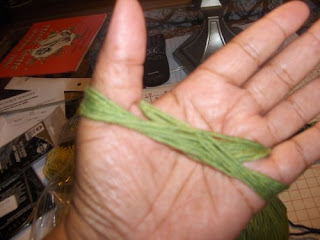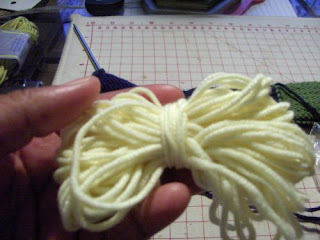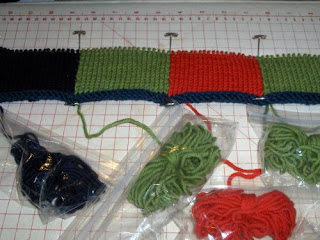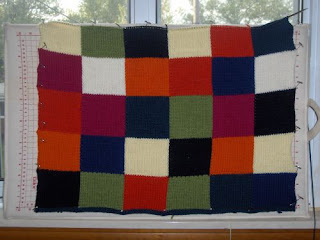
Along with learning a new knitted technique, I also like to know a bit about the meaning of the technique. The word "intarsia" (in-tar-zha) comes from the Italian intarsio, or inlaying (usually wood). In knitting, the term refers to the integration of isolated blocks of color into a project.
 Intarsia is knitting using a separate piece of yarn for each of the areas of color, linking them together as you work across the row. It frequently leads to a large number of pieces of yarn dangling from your work; I found this to be somewhat intimidating at first.
Intarsia is knitting using a separate piece of yarn for each of the areas of color, linking them together as you work across the row. It frequently leads to a large number of pieces of yarn dangling from your work; I found this to be somewhat intimidating at first.  Charts are very commonly used with intarsia knitting, and it is very important to keep track of where you are. The Party Parka’s chart is very easy to read because the blocks of color are counted by rows and the color changes are charted in blocks of color (very intarsia 101).
Charts are very commonly used with intarsia knitting, and it is very important to keep track of where you are. The Party Parka’s chart is very easy to read because the blocks of color are counted by rows and the color changes are charted in blocks of color (very intarsia 101). When I linked the sections of color together, I worked along the row as usual until I come to the place where the next color change was to begin. With the OLD color yarn on the wrong side of the work (where it would naturally tend to be unless doing something fancy), I placed the OLD color of yarn over the top of the NEW color, before I pick up and started working with the new color. I also held the new color taunt before I knitted or purled it to make a tight join without holes. There is definitely an art to get good tension in intarsia knitting.
When I linked the sections of color together, I worked along the row as usual until I come to the place where the next color change was to begin. With the OLD color yarn on the wrong side of the work (where it would naturally tend to be unless doing something fancy), I placed the OLD color of yarn over the top of the NEW color, before I pick up and started working with the new color. I also held the new color taunt before I knitted or purled it to make a tight join without holes. There is definitely an art to get good tension in intarsia knitting.
